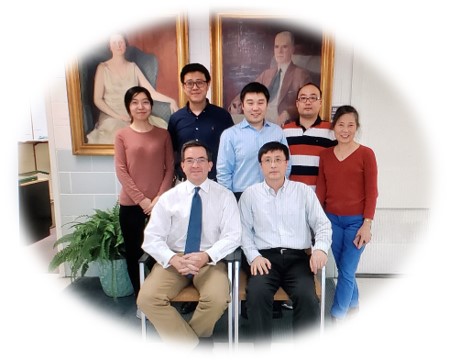Surgical Oncology
In Focus: Mechanisms and Preventive Approaches to Carcinogenesis

Robert C. Martin, MD, PhD, Professor, Director, Div. Surgical Oncology, Vice Chair, Dept. Surgery
Yan Li, PhD Associate Professor
A Radical Idea
Could a Nanoknife (irreversible electroporation, IRE) help to double the survival rate of pancreatic cancer patients with chemo-therapy and target-therapy? Could a natural boost help prevent cancers of the esophagus and liver? Could gold nanorods based binary bomb accurately target the cancers of the esophagus and liver? Dr. Martin heads the surgical oncology laboratory with NIH Grant support to study the preventive effects of phyto-chemicals, shocking the pancreatic cancer cells by IRE and multiple-drugs delivery by gold nanorods. Dr. Li runs the laboratory and works with the research team to establish the cancer animal models and to explore the molecular mechanisms of cancer therapy and prevention.
Pancreatic adenocarcinoma
Pancreatic adenocarcinoma (PDAC) remains a highly fatal disease that is increasing in incidence. IRE has demonstrated an effective local modality for locally advanced (stage III) pancreatic adenocarcinoma. The Laboratory's researchers are investigating that IRE creates a transient tumor lysis that may not only increase the chemo-agents sensitivity to tumor cells, but also disturb the immune regulatory cells (Tregs) post electroporation. They find that in situ IRE procedure provides a clinical window of opportunity to potentiate clinical efficacy in combination of chemo-immuno-therapy.
Hepatocellular Carcinoma
Hepatocellular carcinoma (HCC) is one of the most frequently occurring cancers worldwide. Evidence indicates that nonalcoholic steatohepatitis (NASH) and cirrhosis are responsible for many cases of HCC. Laboratory's researchers are investigating the precancerous condition and mechanisms, especially, the lipid metabolic signaling linked transition from benign hepatocyte to HCC. They find that the endocrine fibroblast growth factors 19 and 21 (FGF19 and 21) may play critical roles, with metabolic benefits against NASH and with the effect of down-regulation of T helper (TH)-17-interleukin (IL)-17 axis against HCC.
Esophageal Adenocarcinoma
The mucosal micro-environment is responsible for the development of esophageal cancer. It is believed that gastro-esophageal reflux disease (GERD) is an underlying trigger for the development of Barrett’s esophagus and esophageal adenocarcinoma. Certain phytochemicals (resveratrol, curcumin and anthocyanin) are with protective and therapeutic effects against esophageal adenocarcinoma, however the poor bioavailability of most phytochemicals is the major obstacle for clinical application. Laboratory's researchers invent a gold nanorods based binary bomb loaded with phytochemicals accurately targeting the cancers.
